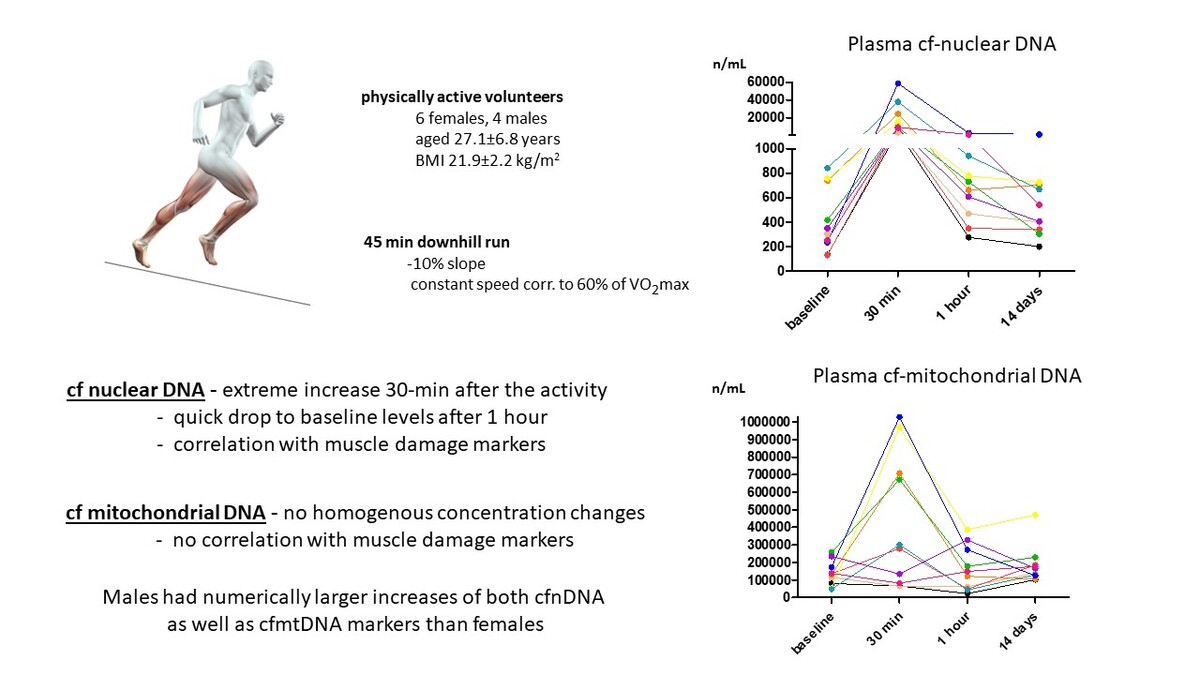Current issue
Archive
Manuscripts accepted
About the Journal
Editorial office
Editorial board
Section Editors
Abstracting and indexing
Subscription
Contact
Ethical standards and procedures
Most read articles
Instructions for authors
Article Processing Charge (APC)
Regulations of paying article processing charge (APC)
HEALTHY LIFESTYLE / RESEARCH PAPER
Changes in plasma concentration of cell-free DNA as a response to physical activity
1
Institute for Clinical and Experimental Medicine, Prague, Czech Republic
2
3rd Department of Internal Medicine, General University Hospital and 1st Faculty of Medicine, Charles University, Prague
3
Institute of Rheumatology and Department of Rheumatology, 1st Faculty of Medicine, Charles University, Prague, Czech Republic
4
Department of Rehabilitation and Sports Medicine, 2nd Faculty of Medicine, Charles University, University Hospital Motol, Prague, Czech Republic
5
Department of Biomedical Technology, Faculty of Biomedical Engineering, Czech Technical University in Prague, Kladno, Czech Republic
6
3rd Department of Internal Medicine, General University Hospital and 1st Faculty of Medicine, Charles University, Prague, Czech Republic
Submission date: 2025-01-07
Final revision date: 2025-04-22
Acceptance date: 2025-06-01
Online publication date: 2025-06-22
Corresponding author
Michal Tomčík
Institute of Rheumatology and Department of Rheumatology, 1st Faculty of Medicine, Charles University, Prague, Czech Republic
Institute of Rheumatology and Department of Rheumatology, 1st Faculty of Medicine, Charles University, Prague, Czech Republic
KEYWORDS
TOPICS
ABSTRACT
Introduction:
Plasma concentrations of cell-free DNA (cfDNA) serve as markers of overtraining or muscle injury. We have examined, if nuclear (n) and mitochondrial (mt) cfDNA has the potential as a marker of muscle burden or damage.
Material and methods:
Ten healthy, physically active volunteers (6 females, aged 27.1±6.8 years) performed a downhill running test. Samples for cfnDNA and cfmtDNA analysis were collected before, 30 minutes, 1 hour, and 14 days after the downhill run. CfnDNA and cfmtDNA (two markers for both) were analysed using qPCR.
Results:
There was an extreme (~ 40-times) increase in cfnDNA at the 30-min time-point against the baseline (p<0.00001 for both markers), followed by a quick drop to baseline levels after 1 hour after the end of the downhill run for all subjects. In contrast, plasma levels of cfmtDNA did not increase significantly (p=0.27 and 0.12). It reflects the fact, that in 6 subjects, the pattern was similar as for cfnDNA but in 4 subjects rather a decrease of cfmtDNA concentration was observed at the 30-mi time-point. These differences correlate with age, BMI, and sex of the participants. Plasma cfnDNA significantly (p<0.01 for all) correlated with concentrations of muscle damage markers such as AST, ALT, and lactate dehydrogenase, and chemokines MIP-1α and IP-10 (positive). No homogenous correlation between cfmtDNA and biomarkers was detected.
Conclusions:
Our study confirms the extreme release and clearance of cfnDNA in physically active subjects after strenuous exercise. In contrast, the trajectory of cfmtDNA concentrations seems to have much higher inter-individual variability than cfnDNA concentrations.
Plasma concentrations of cell-free DNA (cfDNA) serve as markers of overtraining or muscle injury. We have examined, if nuclear (n) and mitochondrial (mt) cfDNA has the potential as a marker of muscle burden or damage.
Material and methods:
Ten healthy, physically active volunteers (6 females, aged 27.1±6.8 years) performed a downhill running test. Samples for cfnDNA and cfmtDNA analysis were collected before, 30 minutes, 1 hour, and 14 days after the downhill run. CfnDNA and cfmtDNA (two markers for both) were analysed using qPCR.
Results:
There was an extreme (~ 40-times) increase in cfnDNA at the 30-min time-point against the baseline (p<0.00001 for both markers), followed by a quick drop to baseline levels after 1 hour after the end of the downhill run for all subjects. In contrast, plasma levels of cfmtDNA did not increase significantly (p=0.27 and 0.12). It reflects the fact, that in 6 subjects, the pattern was similar as for cfnDNA but in 4 subjects rather a decrease of cfmtDNA concentration was observed at the 30-mi time-point. These differences correlate with age, BMI, and sex of the participants. Plasma cfnDNA significantly (p<0.01 for all) correlated with concentrations of muscle damage markers such as AST, ALT, and lactate dehydrogenase, and chemokines MIP-1α and IP-10 (positive). No homogenous correlation between cfmtDNA and biomarkers was detected.
Conclusions:
Our study confirms the extreme release and clearance of cfnDNA in physically active subjects after strenuous exercise. In contrast, the trajectory of cfmtDNA concentrations seems to have much higher inter-individual variability than cfnDNA concentrations.
Share
RELATED ARTICLE
We process personal data collected when visiting the website. The function of obtaining information about users and their behavior is carried out by voluntarily entered information in forms and saving cookies in end devices. Data, including cookies, are used to provide services, improve the user experience and to analyze the traffic in accordance with the Privacy policy. Data are also collected and processed by Google Analytics tool (more).
You can change cookies settings in your browser. Restricted use of cookies in the browser configuration may affect some functionalities of the website.
You can change cookies settings in your browser. Restricted use of cookies in the browser configuration may affect some functionalities of the website.



